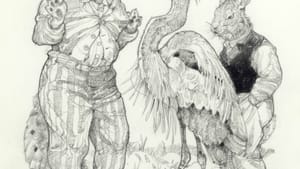Stay in the Loop
BSR publishes on a weekly schedule, with an email newsletter every Wednesday and Thursday morning. There’s no paywall, and subscribing is always free.
Believe in pictures
The Delaware Art Museum presents ‘Fairy Tales to Nursery Rhymes'

Years before the Droller Collection of Picture Book Art was born, Michael Droller fell in love with a print he received as a graduation gift, but he had no idea that it came from a picture book. A few years later, in a California flea market, his wife Esther found the image illustrating a book of poems by Eugene Field: it was by the great Maxfield Parrish (1870-1966). Now, that Parrish print is the opening image in the Delaware Art Museum’s exhibition Fairy Tales to Nursery Rhymes.
Esther Droller purchased that Eugene Field first edition as a gift for her husband after she found it at the flea market, and the Droller collection was born. Collecting books (1,500 to date) led Michael Droller to acquire the prints and originals that illustrated them, and 100 artworks are now on display in this Delaware exhibition.
Walking into books
The title may evoke childhood bedtimes: these are images from stories read to children over the past 100 years. But most are filled with visual depth, and they are far from simplistic.
Oddly angled walls break up the large exhibition gallery: 12-foot-tall “books” with exhibition themes on their spines and pages open to display the art. Curator Mary Holahan chose this presentation to symbolize the magic of reading—walking into another world—and the wall colors are lifted directly from the artworks. A case displays some artist-inscribed volumes, and there is a book-stocked reading area with works by exhibition illustrators.
A passionate collector
At the show’s opening, Droller acknowledged gaining new insights from Holahan’s text; also scattered throughout the exhibition are wall cards titled “What a kid sees.” The museum engaged young viewers to preview the art, and it’s refreshing to read their comments.
Collectors become enamored both with the objects they collect and the people who create them, and Droller is no exception. He established relationships with “his” illustrators, and many contemporary items have a personal story displayed next to them. Not a taciturn man, Droller is voluble about his passionate collecting: “I never regretted anything I bought, only what I left behind.”
This exhibition originated in 2017 in Massachusetts at the Eric Carle Museum, which reassembled it for Delaware; this is its only other venue. There are multiple renderings of familiar stories (Cinderella, Pinocchio, the Pied Piper, Aesop’s fables), and works are about equally divided between “golden age” illustrators and those of our time—from Kate Greenaway (1846-1901) and Arthur Rackham 1867-1939) to celebrated moderns like Jerry Pinkney (b. 1939), Maurice Sendak (1928-2012), and Chris Van Allsburg (b. 1948).

Droller traveled extensively in his medical profession, so he also collected internationally. Artists from eight countries are represented, including a loving tribute to John Thomas “Tomi” Ungerer (France, 1931-2019) who died just last month.
Riches in the artists’ hand
The first purpose of any picture book is to speak intimately to the child who holds it. But seeing the artist’s hand opens up myriad visual riches. Especially beautiful are illustrations for Goldilocks and the Three Bears (based on Inuit culture) and The First Dog, both by Jan Brett (b. 1949), with Droller’s daughter and son as models. And there is a richly detailed illustration for Nancy Willard’s A Visit to William Blake’s Inn by the legendary team of Alice Provensen (1918-2018) and her husband Martin (1916-1987).
The Museum shop has stocked many stunning picture books by artists in the exhibition, along with some interesting outliers like Sleeping Beauty illustrated by fashion designer Christian Lacroix and a Salvador Dalí version of Alice’s Adventures in Wonderland.
Not (only) for children
Fairy Tales to Nursery Rhymes is not an exhibition that immediately speaks volumes. It requires that the viewer slow down—ideally to the speed of reading a book. Works are small and must be appreciated up close. Styles vary widely, and the content is often more multilayered than might be expected, reflecting the curiosity or uncertainty of childhood.
This is not a children’s exhibition. Although its vibrancy and approachable subject matter will certainly engage families, the Brothers Grimm were, well, pretty grim. You’ll probably remember some artworks from books you read as a youngster—or had read to you—or that you shared with a child. But here, you may be inspired to revisit and reinterpret them, looking in the familiar for something altogether new. Take a cue from the inimitable G.K. Chesterton, quoted on an exhibition wall: “Stand up and keep your childishness [and] . . . don’t believe anything that can’t be told in colored pictures.”
What, When, Where
Fairy Tales to Nursery Rhymes: The Droller Collection of Picture Book Art. Through May 12, 2019, at the Delaware Museum of Art, 2301 Kentmere Parkway, Wilmington, DE. (302) 571-9590 or delart.org.
Sign up for our newsletter
All of the week's new articles, all in one place. Sign up for the free weekly BSR newsletters, and don't miss a conversation.
 Gail Obenreder
Gail Obenreder